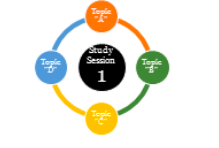This is part 6 in our 6 part education series and covers enhancing learning using interleaving techniques.
What are interleaving techniques?
Interleaving is a method that arranges and recalls information in a noncontiguous manner, making learning “systems” more efficient and reliable. Interleaving helps learners establish and use brain files for better retrieval. It benefits both instructors and learners by uncovering errors or gaps in previous knowledge.
How do I teach using it?
> Design learning activities so that previous knowledge, especially complex or difficult to master knowledge, is regularly featured in different shapes and forms in class and/or in online.
> Begin class with an active learning exercise to help retain knowledge. Revisit this content 20-30 minutes into class time to help learners self-calibrate their retained learning. Be creative! This is an easy way to use low stakes games in class. Remind learners that as a professional school, UNMC is invested in helping them practice “owning an answer” so they are ready for this in high stakes patient-centered situations.
> Design learning materials that are less focused around a PowerPoint lecture, and more around key concepts. This way, studying can easily be constructed and reconstructed for strategic, segmented study.
How do I teach students how to do it?
> Inform students that rereading chapters and notes from start to finish is not an efficient way to maximize learning. Study habits that may have worked in K-12 or undergraduate learning don’t always translate to a professional school setting. Encourage students to continuously evaluate the impact of their own learning strategies. This includes habits between study sessions.
> As an expert, explain to students the strategies that you have found to be effective in mastering content. Don’t make them hunt for solutions. Remind students that interleaving techniques may feel harder in application, but the reward will come later when application is necessary.
Don’t make them hunt for solutions. Remind students that interleaving techniques may feel harder in application, but the reward will come later when application is necessary.
> Interleaving should not be restricted to certain time blocks (i.e., switching topics every 30 minutes). Rather, interleaving is a system or process by which learners can avoid binging and purging cycles, a known detriment to sustained knowledge gains. Student directed interleaving habits support focused and varied, but not exclusive, studying structures. These can take on a wide ranging look and feel.
Want to learn more?
Contact Gary Beck Dallaghan, PhD, at gbeck@unmc.edu or Linda M. Love, EdD, at lmlove@unmc.edu.
Read the rest of the Education Series:
- Part 1: Enhancing Learning Using Spaced Practice by Dr. Linda M. Love
- Part 2: Learning Through Retrieval Practice by Dr. Gary Beck Dallaghan
- Part 3: Enhancing Learning Through Concrete Examples by Dr. Linda M. Love
- Part 4: Learning Through Elaboration by Dr. Gary Beck Dallaghan
- Part 5: Learning Through Dual Coding by Dr. Gary Beck Dallaghan
- Part 6: Enhancing Learning Using Interleaving Techniques by Dr. Linda M. Love
View tip sheet in an easy-to-print format
About the Author
Dr. Linda M. Love is the Assistant Director of Faculty Development at the University of Nebraska Medical Center. She has over a decade of experience working with faculty development and continues to expand her skills in mentoring, coaching, adult learning, and higher education administration.
lmlove@unmc.edu | @2LindaMLove
References
- Ambrose, S. A., Bridges, M. W., DiPietro, M., Lovett, M. C., & Norman, M. K. (2010). How learning works: Seven research-based principles for smart teaching. John Wiley & Sons.
- Brown, P. C., Roediger, H. L., & McDaniel, M. A. (2014). Make it stick. Harvard University Press.
- Rohrer, D. (2012). Interleaving helps students distinguish among similar concepts. Educational Psychology Review, 24, 355-367.
- Weinstein, Y. & Smith, M (2017). Learn to Study Using Concrete Examples. Retrieved at www.learningscientists.org.
